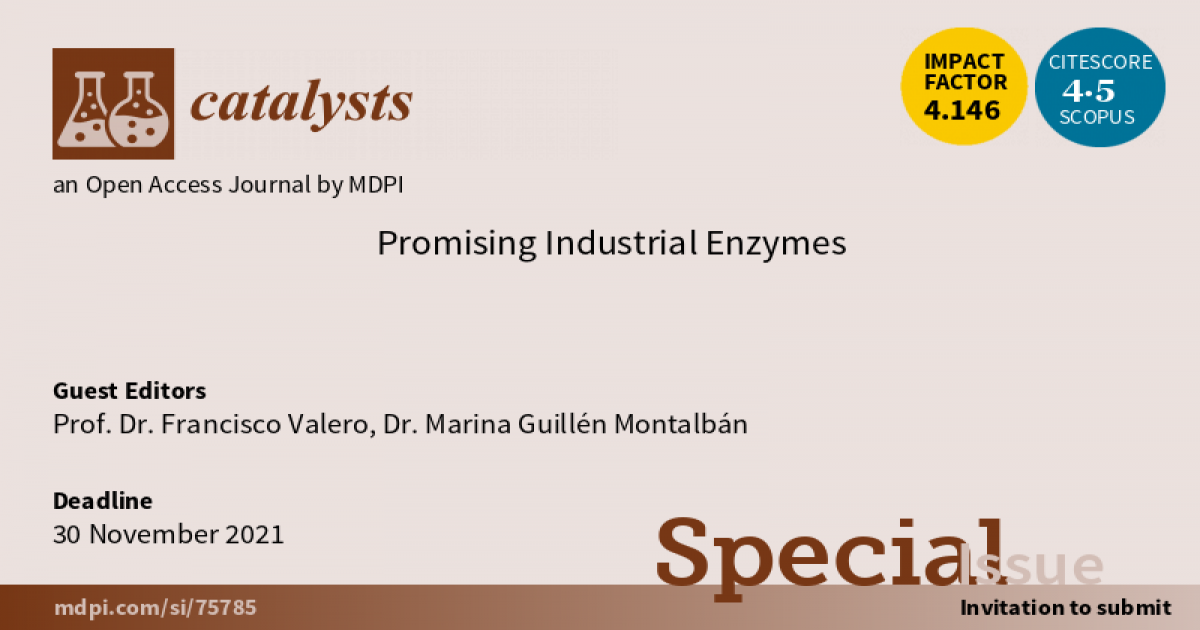Promising Industrial Enzymes
A special issue of Catalysts (ISSN 2073-4344). This special issue belongs to the section "Biocatalysis".
Deadline for manuscript submissions: closed (31 December 2022) | Viewed by 30260

Special Issue Editors
Interests: biochemical engineering; bioprocess engineering, production of recombinant proteins in the cell factory Pichia pastoris; monitoring modeling and control of bioprocesses and applied biocatalysis (lipases)
Interests: The main research interests are focused on industrial biotechnology, especially on applied biocatalysis, bioprocess development, multi-enzymatic systems, bioreactor design and enzyme immobilization
Special Issue Information
Dear Colleagues,
The industrial applications of enzymes have been increasing in the last decade, becoming a real cost-effective alternative as a substitute for chemical processes. It represents a more environmentally sustainable approach, greener than the traditional chemical industry and in agreement with the fundamentals of circular economy. In fact, the number of enzymes with industrial applications is increasing, including not only the classical proteases, amylases or lipases.
The present Special Issue is focused on recent research and reviews about how different approaches have managed to improve enzymes for industrial applications. Research topics may include: i) examples of enhanced enzymes by directed evolution, enzyme engineering and metagenomics; ii) advances in bioprocess engineering and cell factories to increase the heterologous production of enzymes; iii) bioprocess scaling-up to industrial levels; iv) novel approaches to improve the stability and reutilization of the industrial enzymes; v) medium engineering as the used of supercritical fluids, ionic liquids, deep eutectic solvents and novel reaction medium; vi) multi-enzymatic systems development, including cofactor regeneration; vii) process intensification and successful examples of new industrial enzymatic applications.
Prof. Dr. Francisco Valero
Dra. Marina Guillén Montalbán
Guest Editors
Manuscript Submission Information
Manuscripts should be submitted online at www.mdpi.com by registering and logging in to this website. Once you are registered, click here to go to the submission form. Manuscripts can be submitted until the deadline. All submissions that pass pre-check are peer-reviewed. Accepted papers will be published continuously in the journal (as soon as accepted) and will be listed together on the special issue website. Research articles, review articles as well as short communications are invited. For planned papers, a title and short abstract (about 100 words) can be sent to the Editorial Office for announcement on this website.
Submitted manuscripts should not have been published previously, nor be under consideration for publication elsewhere (except conference proceedings papers). All manuscripts are thoroughly refereed through a single-blind peer-review process. A guide for authors and other relevant information for submission of manuscripts is available on the Instructions for Authors page. Catalysts is an international peer-reviewed open access monthly journal published by MDPI.
Please visit the Instructions for Authors page before submitting a manuscript. The Article Processing Charge (APC) for publication in this open access journal is 2200 CHF (Swiss Francs). Submitted papers should be well formatted and use good English. Authors may use MDPI's English editing service prior to publication or during author revisions.
Keywords
- industrial enzymes
- direct evolution
- metagenomics
- enzyme engineering
- heterologous production
- bioprocess engineering
- scale-up
- immobilization
- industrial biocatalysis
- multi-enzymatic synthesis
- cofactor regeneration
- bioreactor design
- medium engineering
- process intensification
- bioeconomy
Benefits of Publishing in a Special Issue
- Ease of navigation: Grouping papers by topic helps scholars navigate broad scope journals more efficiently.
- Greater discoverability: Special Issues support the reach and impact of scientific research. Articles in Special Issues are more discoverable and cited more frequently.
- Expansion of research network: Special Issues facilitate connections among authors, fostering scientific collaborations.
- External promotion: Articles in Special Issues are often promoted through the journal's social media, increasing their visibility.
- e-Book format: Special Issues with more than 10 articles can be published as dedicated e-books, ensuring wide and rapid dissemination.
Further information on MDPI's Special Issue polices can be found here.






